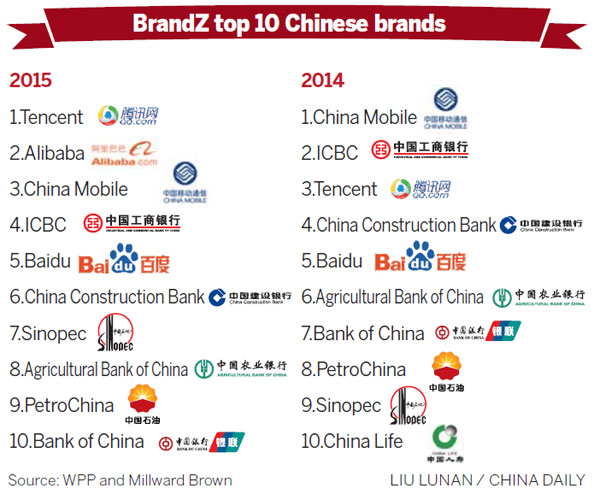Booming brands mark change in China
Updated: 2015-02-06 07:39
By Mike Bastin(China Daily Europe)
|
|||||||||||
Private, market-driven Chinese companies are making world-leading gains in value
It was less than one week ago that the launch of the annual BrandZ report on the 100 most valuable Chinese brands for 2015 took place.
This is the fifth anniversary edition of market research firm Millward Brown's BrandZ study of Chinese brands. This BrandZ edition, by now easily the definitive resource on Chinese brands and the dynamics that drive their growth, presents key findings that may well lead many to form the view that this marks the era in which Chinese brands have come of age.

Amongst many, key highlights include: an increase in brand value of 22 percent for the top 100 most valuable Chinese brands year-on-year to a total value of $464.2 billion, a far greater increase than that recorded for the world's top 100 most valuable brands, or for the most valuable brands of Brazil and Latin America.
Further telling highlights include the meteoric rise in the brand value of Tencent, just one of China's many burgeoning Internet brands, which doubled in value year-on-year, representing the fastest growth in brand value across the world, not just in China and Asia.
One of Tencent's major Chinese competitors, Alibaba, entered the top 100 most valuable Chinese brands for the first time at number two in the rankings.
Indeed it was Alibaba's US initial public offering last year that perhaps registered the most explosive burst onto the world stage of Chinese brands. This IPO raised a world record $25 billion.

But are these incredibly impressive facts and figures part of a definite upward trend or is further evidence necessary before Chinese brands can really lay claim to any sizeable, quantum leap in national and even international competitiveness?
This year's BrandZ edition goes some way in answering this question, with a look back over the key findings of the previous year's reports. This reveals the unequivocal fact that a sizeable and apparently permanent and unstoppable shift in brand value and brand power from China's major state-owned enterprises to younger, dynamic, market-driven and privately owned brands continues to take place.
Over the past five years, the brand value of China's top 50 brands has increased by a massive 59 percent, but most telling of all is the comparison in brand value during that period between the most valuable top 50 Chinese brands, many of which are market-driven and privately owned, and a weighted index of Chinese brands generally. The former grew by a staggering 85 percent with the latter recording only a 4 percent rise.
Of course one of the reasons for this recent and disproportionate rise in Chinese brands is the changing Chinese business environment, which has become far more conducive toward brand building in recent years.
Changes and developments include a far more open Chinese business environment in which private enterprise and the private sector generally are far more welcome, and a Chinese consumer who is far more receptive to brands.
Of course European brands are also in a position to take advantage of this far more receptive brand-building environment across more and more of the Chinese mainland.
Another consistent finding and apparent trend during the five years of BrandZ reports of the most valuable Chinese brands - which also supports the view that Chinese brands have now come of age - is the increasing international emergence of more and more Chinese brands. Specifically, this year's BrandZ edition reports on major overseas brand acquisition, collaboration and investment activity and aspiration by Chinese brands, across many industrial sectors.
But once again it is the remarkable rise in brand value of the leading market-driven Chinese brands, which now combine to comprise just under half the total value of the top 100 Chinese brands, that points purposefully to permanent, lasting change.
Further evidence in support of the coming of age of Chinese brands can be found in this year's findings that technology brands surpassed even China's banking sector as the category with the largest brand value, standing at an enormous $106.9 billion, which is not far short of almost a quarter of the total value of the top 100 Chinese brands for 2015.
Moreover, BrandZ 2015 reports that the growth in Chinese technology brands has been more than matched by Chinese retail brands. In fact, the Chinese retail sector led all of the 21 BrandZ categories in brand value growth. Chinese retail brand value grew by a stupendous 3,827 percent, driven largely by the addition of Alibaba. Technology brands grew at what would appear to be a table-topping 78 percent but even leaving out Alibaba's arrival, retail still grew by 64 percent.
Furthermore, the Chinese automotive sector, usually a major engine of economic growth, also fared well in this latest BrandZ report with an impressive increase of 141 percent in year-on-year brand value.
This year's BrandZ report also makes clear a subtle but critical change in the role of China's major state-owned enterprise brands, which typically continue to dominate across the banking, telecommunications and insurance sectors. While SOE brand values generally remain large and growing, BrandZ provides findings that suggest a more supportive, facilitative and enabling role has now been adopted, which has led to a far more healthy relationship with the rapidly growing members of the private, market-driven Chinese brand community.
This year's report also detects that Chinese consumers are now far more demanding and sophisticated, which has perhaps driven many Chinese brand providers to raise their game.
Media expenditures as well as new product development have also risen among the most valuable Chinese brands.
The BrandZ 2015 findings also point to the increasing opportunities for European brands as a result of this apparent step-change in Chinese brands' competitiveness.
Any rise in competitiveness and attractiveness of Chinese brands will, as BrandZ correctly points out, provide major consumption stimulus across China and, therefore, help market opportunities for all brands to grow in China.
In addition, European brands can also grasp the growth in the number of competitive, potential Chinese brand partners. Increasingly competitive Chinese brands will lead to greater investment in the European brands and increased opportunity for European brands in China.
None of the above should come as any surprise at all. Indeed, my research findings from frequent contact with and constant monitoring of major Chinese brands over the last five years outline a similar trend. It's a trend characterized by increasing confidence among Chinese business leaders and the emergence of a more modern, market-driven brand-building approach inside many Chinese organizations, across many sectors.
In short, it is not just the Chinese brand that has finally come of age; it is the Chinese brand manager who also has come of age.
The author is a visiting professor at the University of International Business and Economics in Beijing and a senior lecturer in marketing at Southampton Solent University's School of Business. The views do not necessarily reflect those of China Daily.

(China Daily European Weekly 02/06/2015 page12)
Today's Top News
Chinese FM eyes 'harvest' for ties with Slovakia
Russia leads UN initiative to target IS
New Greek govt lobbies across Europe for solution to its debt
Birmingham plans to transform city into global financial hub
China: Norway violates rights of Chinese scholar
Italy extradites suspect in theft
A great future for UK-China business relationship
Former IMF chief Strauss-Kahn on trial over pimping charges
Hot Topics
Lunar probe , China growth forecasts, Emission rules get tougher, China seen through 'colored lens', International board,
Editor's Picks

|

|

|

|

|

|





